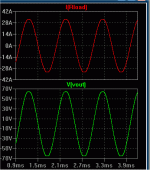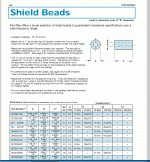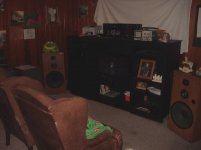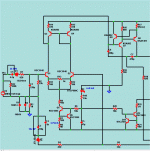I think you are confirming that at 13.5mA to 13.7mA that the protection is affecting the signal being passed through.
I think you are also confirming that the protection transistor starts turning on much earlier than when Vbe~600mVbe.
can you monitor what the protection transistor is doing to the signal when lower values of Vbe are applied? I.e. can you see the start of turning on at lower output current?
12.5 ma is where the signal starts getting effected. The protection transistor goes from a few nA's to .1x mA's Ic. Not to go off-topic for this thread , these enhancements are quite worthy of the ULD as well (including the cap multipliers). A 4Q wilson CM is the only addition I can think to perfect this amp.
OS
what output current could be sourced with this level of VAS current?12.5 ma is where the signal starts getting effected.
12.5mA, how much passes through the 47r? What is the Vbe at turn on?
Last edited:
what output current could be sourced with this level of VAS current?
Way too much !! (below) At 2R the OPS "soft clips" (a side benefit of this technique). Without Q9 ,this topology has exhibits VERY bad clipping behavior.
12.5ma passes through the resistor , and Vbe is close to .6V.
OS
Attachments
Last edited:
voltage clips at ~65Vpk, giving ~32Apk.
That would certainly drive an 8ohm speaker.
Is it sufficient to drive a 6ohm speaker or a 4ohm speaker? probably OK for a 6ohm and not a 4ohm.
At a lower level , It would do ( I've done it.) But not at this level.
4R is essentially ULD/AX triple territory (I will do it).
OS
Hi DaveThe only issue I ever encountered was a tendancy to oscillate at HF - VHF frequencies when employed using high ft devices (as CFP's tend to do) but the cure is a simple ferrite bead at the VAS emitter. The SQ is obviously better without the parasitics but I also found that F14 was the best ferrite for SQ, although I haven't investigated this further.
Being a VHF kinda guy, F14 would be a familiar bead and balun material to you, but of course, Neosid have not been about for some time. My ancient stocks have even dried up and TBH, I can't be certain now whether some are F29 instead. Our local retailers did sell beads occasionally but searching now through The Element14/RS Components lists is digging in a minefield of unknown materials.
One issue is that ferrites are a sintered material having slightly varying properties with the size, shape and processing of the product so you can't always compare materials without direct part comparisons or specs. You often see a bunch of similar formulations used to compensate for this.
Do you perhaps have any idea of current suitable materials or products that would fit into the role of suppression here in the VAS?
For those who feel nauseous at the thought of any ferrite within thirty metres of their audio equipment
 , just think about RF frequencies 100-1,000 times your precious audio. The concern, originating from the misuse of LF ferrite as a saturating core at high power in speaker crossovers, is nothing like a non-saturating low-pass filter that only begins to attenuate beyond several megahertz.
, just think about RF frequencies 100-1,000 times your precious audio. The concern, originating from the misuse of LF ferrite as a saturating core at high power in speaker crossovers, is nothing like a non-saturating low-pass filter that only begins to attenuate beyond several megahertz. Hi Dave
Being a VHF kinda guy, F14 would be a familiar bead and balun material to you, but of course, Neosid have not been about for some time. My ancient stocks have even dried up and TBH, I can't be certain now whether some are F29 instead. Our local retailers did sell beads occasionally but searching now through The Element14/RS Components lists is digging in a minefield of unknown materials.
One issue is that ferrites are a sintered material having slightly varying properties with the size, shape and processing of the product so you can't always compare materials without direct part comparisons or specs. You often see a bunch of similar formulations used to compensate for this.
Do you perhaps have any idea of current suitable materials or products that would fit into the role of suppression here in the VAS?
For those who feel nauseous at the thought of any ferrite within thirty metres of their audio equipment, just think about RF frequencies 100-1,000 times your precious audio. The concern, originating from the misuse of LF ferrite as a saturating core at high power in speaker crossovers, is nothing like a non-saturating low-pass filter that only begins to attenuate beyond several megahertz.

Hi Ian.
You're right about the availability issues. It's a pity that Neosid no longer exists but it might still be possible to find a supplier of old stocks. I actually use a small F14 ferrite coil former (with the 6 holes) but I use it as a bead - using just one of the holes.
Using a 300MHz oscilloscope I have been able to see TV and FM carrier in the pre and PA VAS stages, and use of the ferrite effectively eliminated all RF contamination - as well as any tendency to oscillate. RF bypassing on the supply rails is always a good idea but usually not completely effective and installing a F14 bead negates any need to use ground planes or faraday caging etc. The best ferrite to use is the one that eliminates VHF parasitics and interference without intruding on amplifier performance. You could use a slower VAS device but from my experience is best to use a very fast VAS device with low ccb and to degenerate with ferrite - in a controlled fashion. The F14 permeability curve rises from 3-4 MHZ with higher loss beyond 10MHz. I originally used a Yaesu FT-847 as a RF sig gen to do the ferrite testing but the tabled results were lost when the HDD crashed. I'll redo the tests tomorrow if I have time.
FTR about 16 months ago I was able to buy the entire inventory of components from my local Dick Smith Electronic store when they transformed from hobby to consumer electronics. You might say I did a stock take
Cheers
VHF Dave
Dave , what type of ferrites ? the small ones you see on switching MOSFET gates ? (below 1)
Where would you put them ... on the base leads ?
OS
Hi OS
The f14 ferrite needs to be in series with the vas emitter and preferably as close to the vas device as possible. If you use a small emitter resistor on the VAS then the f14 or F25 bead could be installed over the resistor lead closest to the VAS transistor.
Dave VHF
Thanks for the comments
A great opportunity, eh? I did the same with ACE Radio in the late 1980s. Indeed, I have a number of those 6-hole formers and wired ones too. There's quite a bit more material in those than your average bead, however. I imagine it would take 2-3 beads of say 3.5 x5 mm to approach those big'uns. It's just well I asked.
A great opportunity, eh? I did the same with ACE Radio in the late 1980s. Indeed, I have a number of those 6-hole formers and wired ones too. There's quite a bit more material in those than your average bead, however. I imagine it would take 2-3 beads of say 3.5 x5 mm to approach those big'uns. It's just well I asked.
Hi OS
The f14 ferrite needs to be in series with the vas emitter and preferably as close to the vas device as possible. If you use a small emitter resistor on the VAS then the f14 or F25 bead could be installed over the resistor lead closest to the VAS transistor.
Dave VHF
So integrate it with the degeneration resistor that is VERY close to the main VAS device (R17 below) ?. Insulate the resistor lead and pass 2 turns through the f14. Just to be sure ... is this a f14 ??
An externally hosted image should be here but it was not working when we last tested it.
BTW , you realize this amp has "magical sound". I can't get over it ... had to get new tweeters and mids (below 1)to fully realize just how accurate it's sound was. Near perfection. I will share the final design (below 2 - r25 is just to test CCS current , not on real amp)... 0 thump (not even a "glitch" on the CRO) , 0 offset (0c - 60c) , can't be overdriven , and 100% awesome sound. It will run from 10V to 80V rails maintaining it's 6mA CCS current.
I've built every voltage stage out there and this one stands out. I can swap stages in 30 seconds , so I KNOW.
OS
Attachments
Os, those TV baluns look the part, grade-wise. If they were for VHF reception, rather than just UHF, they'd be suitable. If you have access to the ARRL handbook in some form, it's usually a great guide to ferrites. I see there's some guidelines there too in the catalog you posted. The 6-hole "bead" Dave is using is, in my example, 6mm dia. x10 long.
Thanks for the comments
A great opportunity, eh? I did the same with ACE Radio in the late 1980s. Indeed, I have a number of those 6-hole formers and wired ones too. There's quite a bit more material in those than your average bead, however. I imagine it would take 2-3 beads of say 3.5 x5 mm to approach those big'uns. It's just well I asked.
Yes they are probably 3x standard beads. I will set up a bread board test cct and sweep Z over 1-50 MHz. I should also really use a 10mA dc bias to better simulate a VAS environment.
So integrate it with the degeneration resistor that is VERY close to the main VAS device (R17 below) ?. Insulate the resistor lead and pass 2 turns through the f14. Just to be sure ... is this a f14 ??OS
If it's sold as a vhf grade former then yes it's probably what I call F14.
It's a specific blend of nickel + zinc that's effectively lossy > 10MHz.
NAL F14
Fair -Rite ferrites
This would seem to be the equivalent part in the US. The nearest standard Ni/Zn grade is 43 and fig. 1 (unwound) appears identical. As Dave suggests, a few smaller, plain beads may suffice. I guess we'll hear shortly.
Fair-Rite Catalog | Wound Beads
This would seem to be the equivalent part in the US. The nearest standard Ni/Zn grade is 43 and fig. 1 (unwound) appears identical. As Dave suggests, a few smaller, plain beads may suffice. I guess we'll hear shortly.
Fair-Rite Catalog | Wound Beads
Murata also offer filtering solutions
Noise Suppression Products/EMI Suppression Filters | Products | Murata Manufacturing Co., Ltd.
Noise Suppression Products/EMI Suppression Filters | Products | Murata Manufacturing Co., Ltd.
- Status
- This old topic is closed. If you want to reopen this topic, contact a moderator using the "Report Post" button.
- Home
- Amplifiers
- Solid State
- New Amplifier - ULD Extreme



